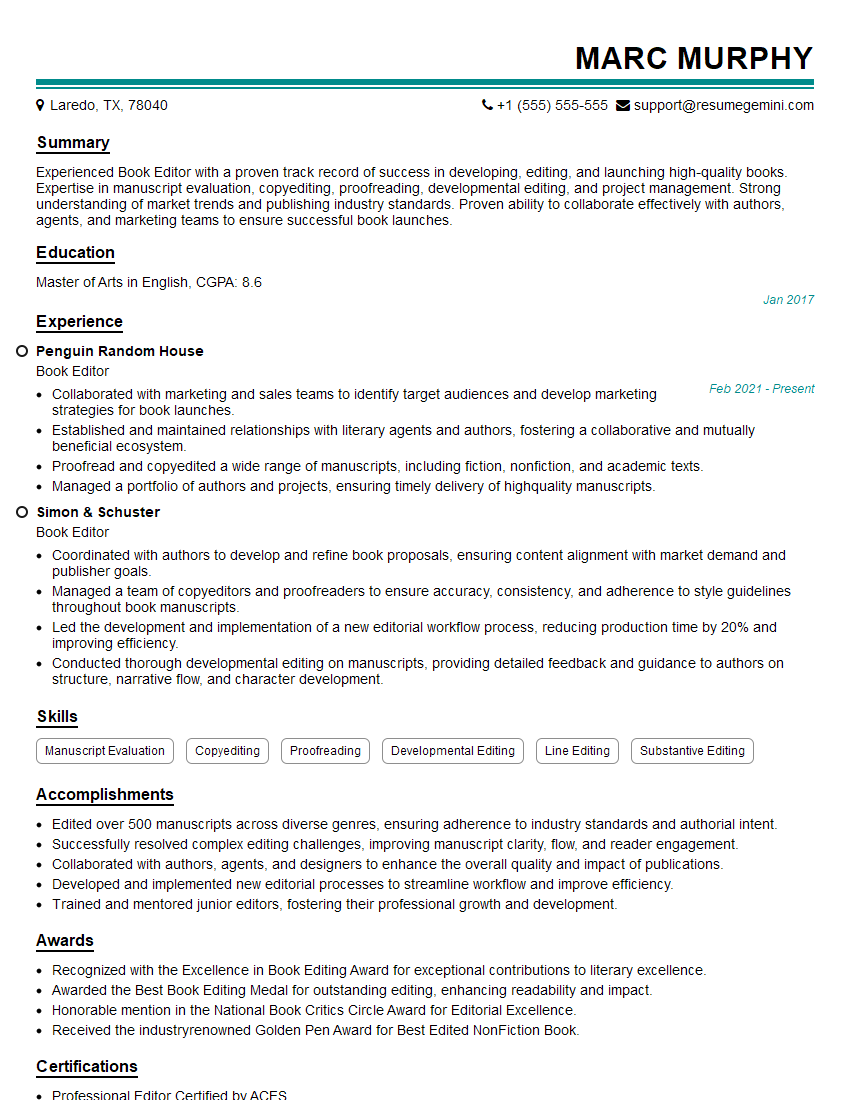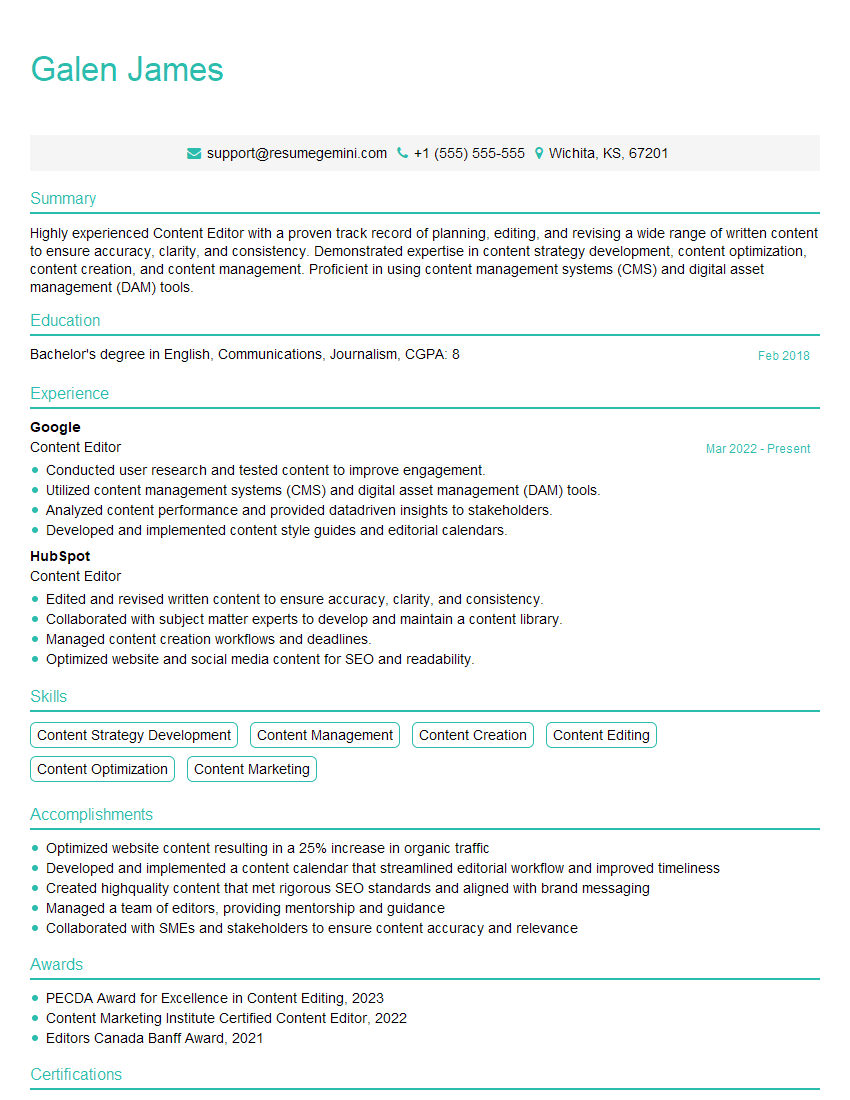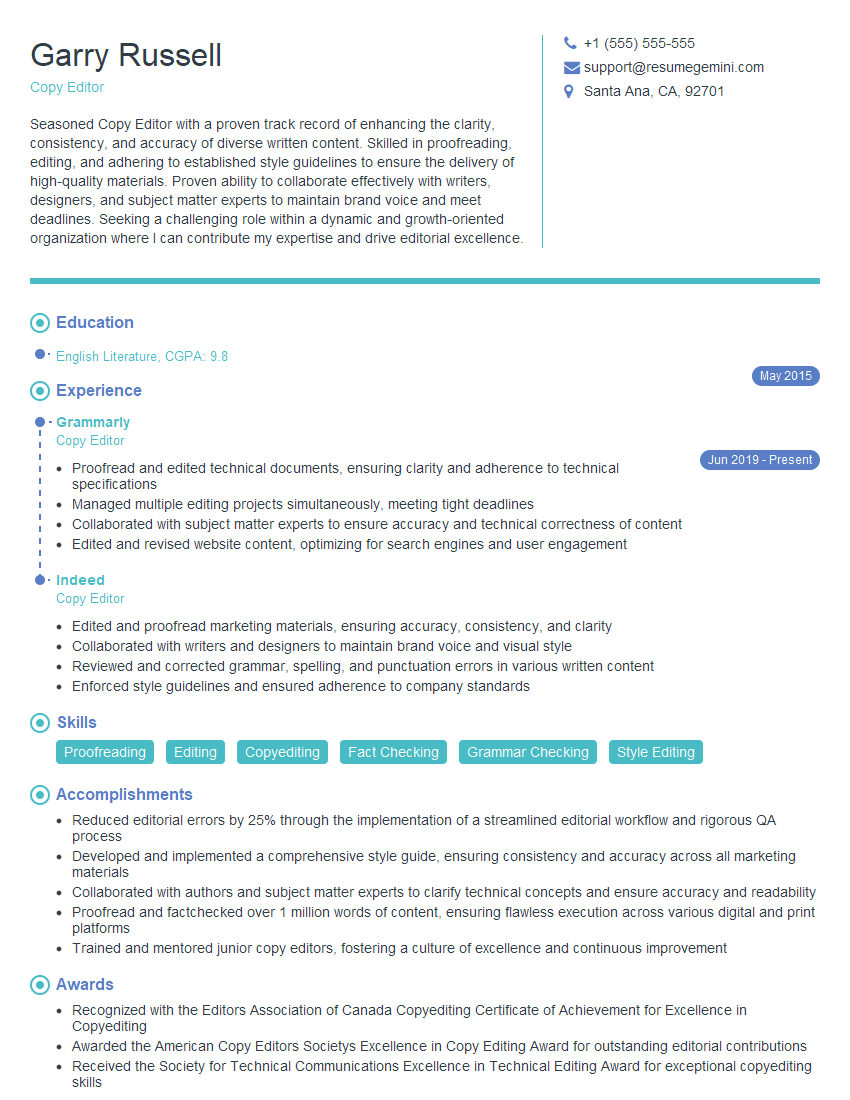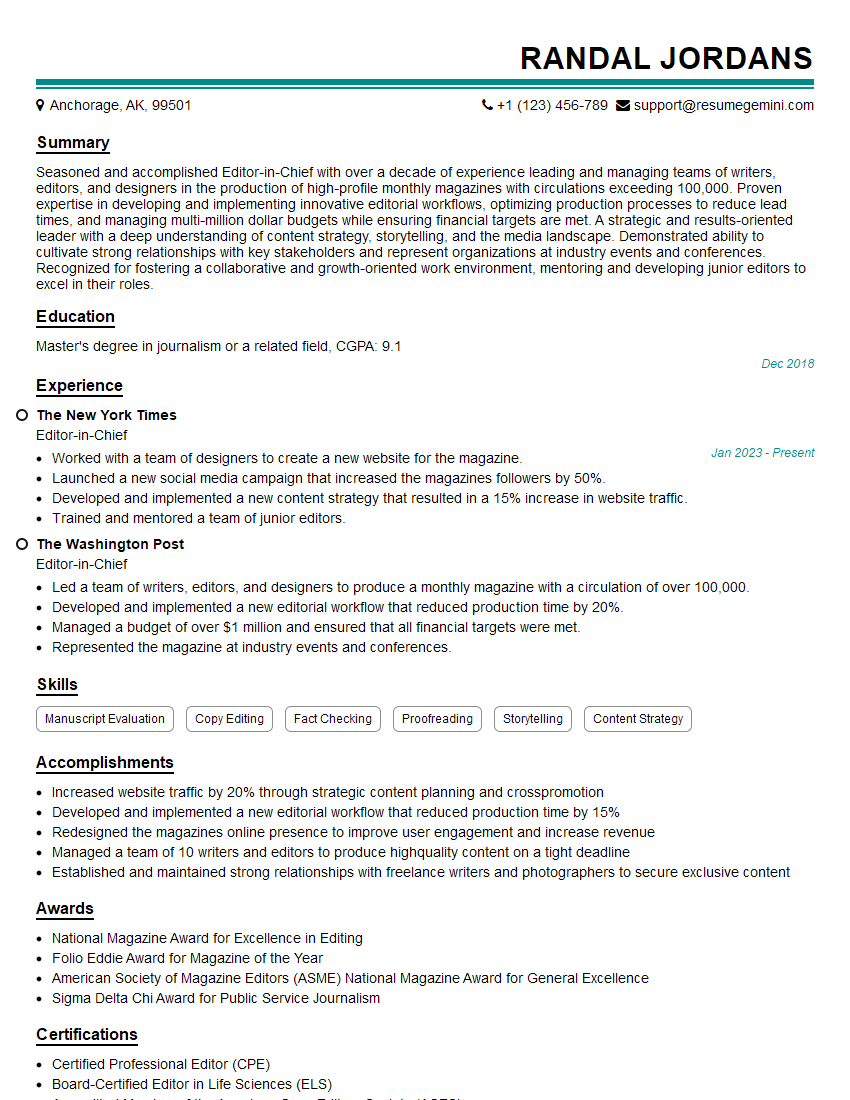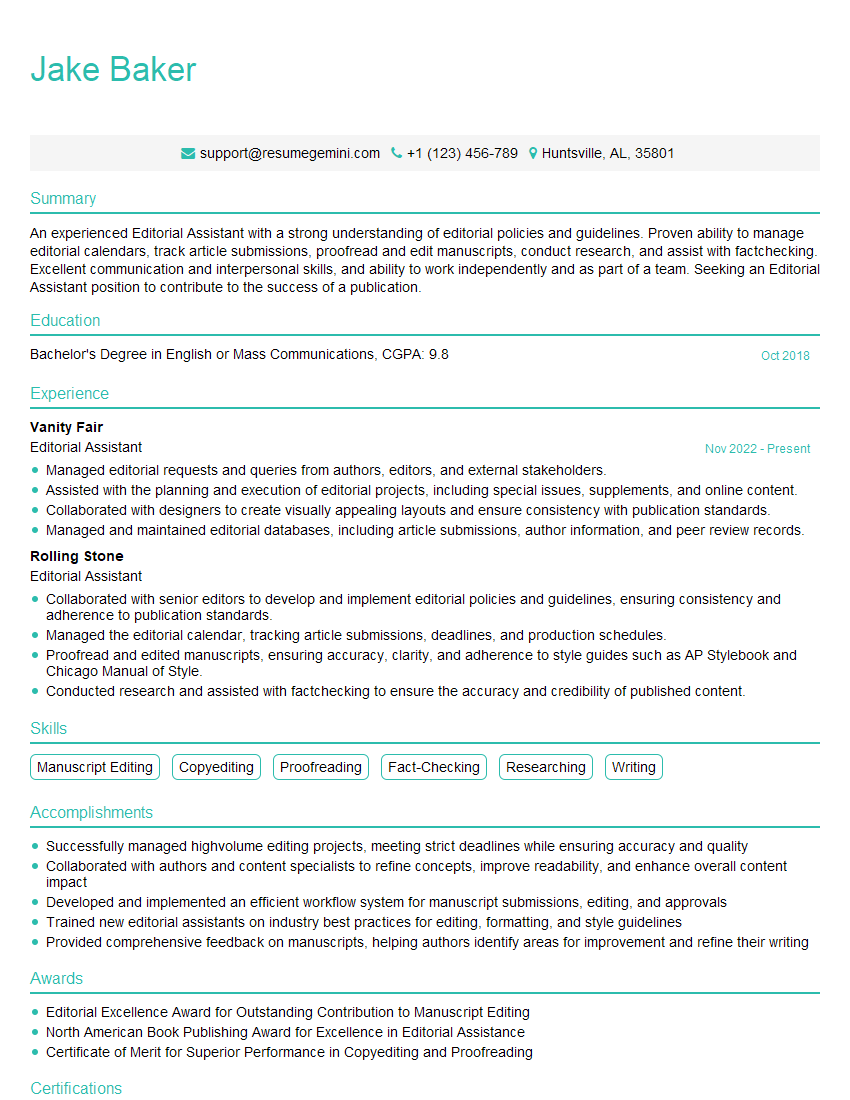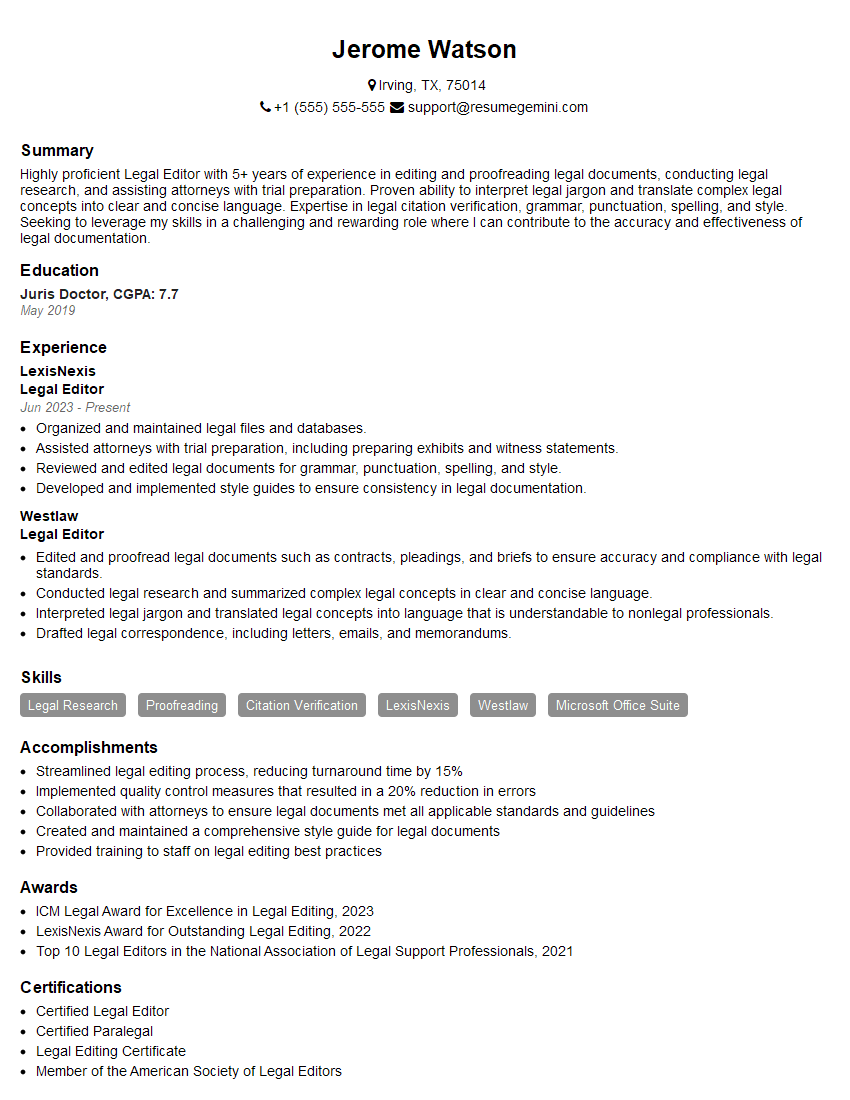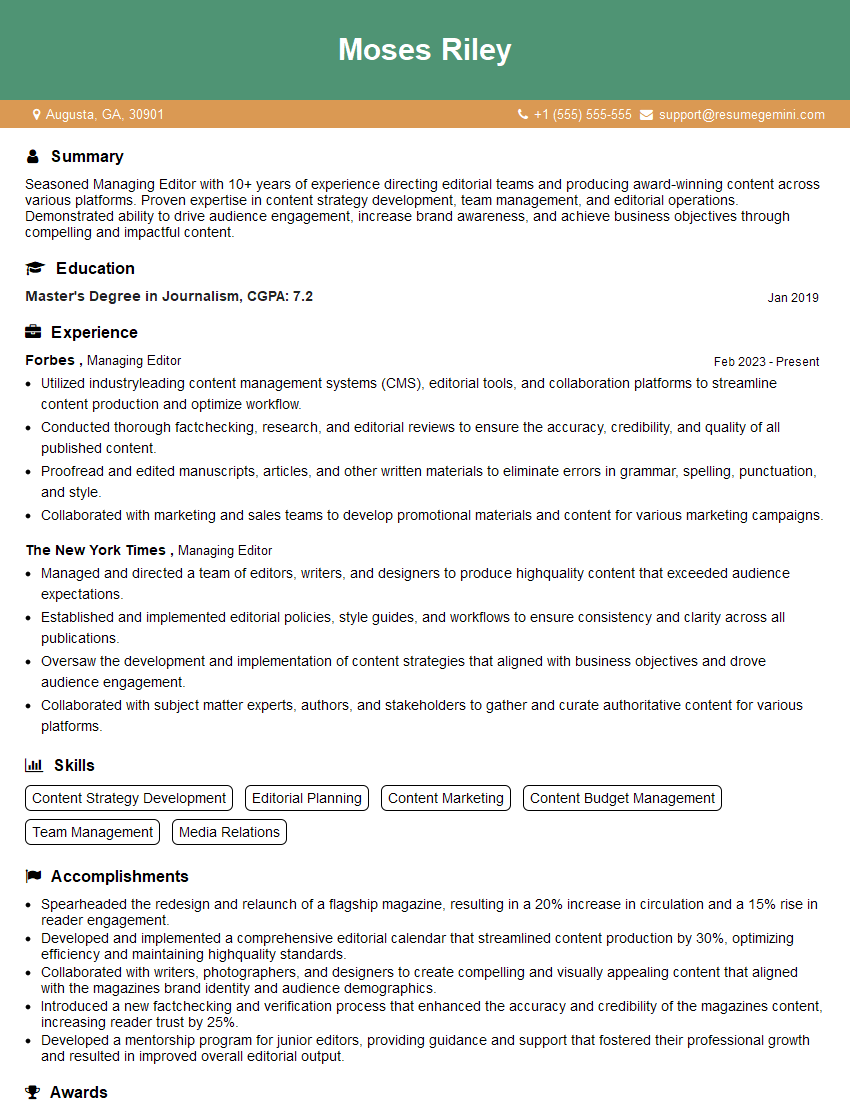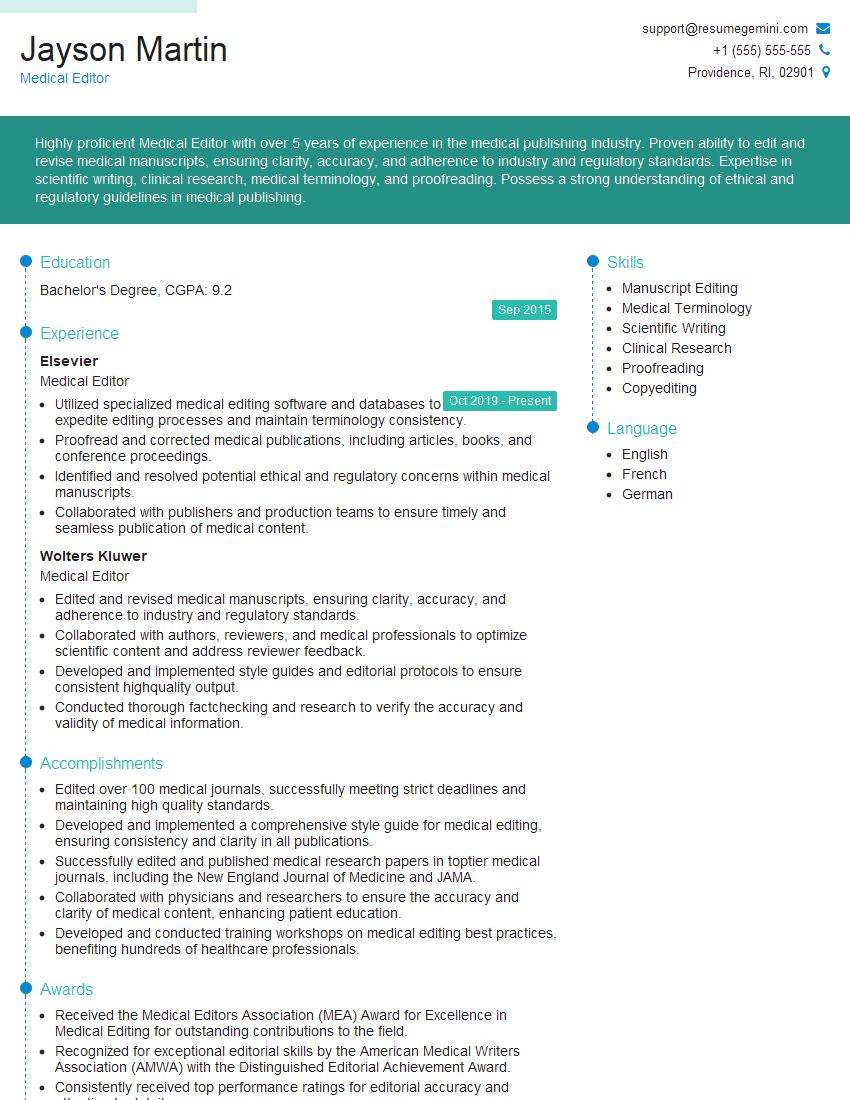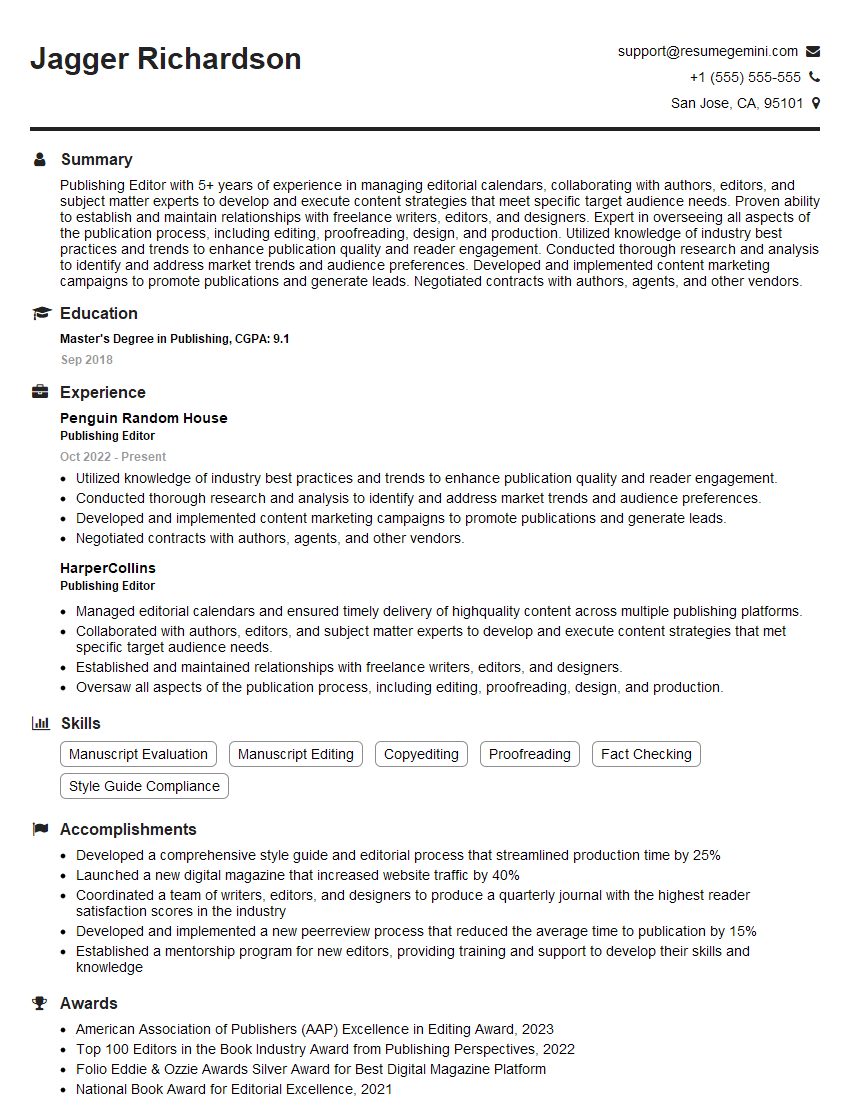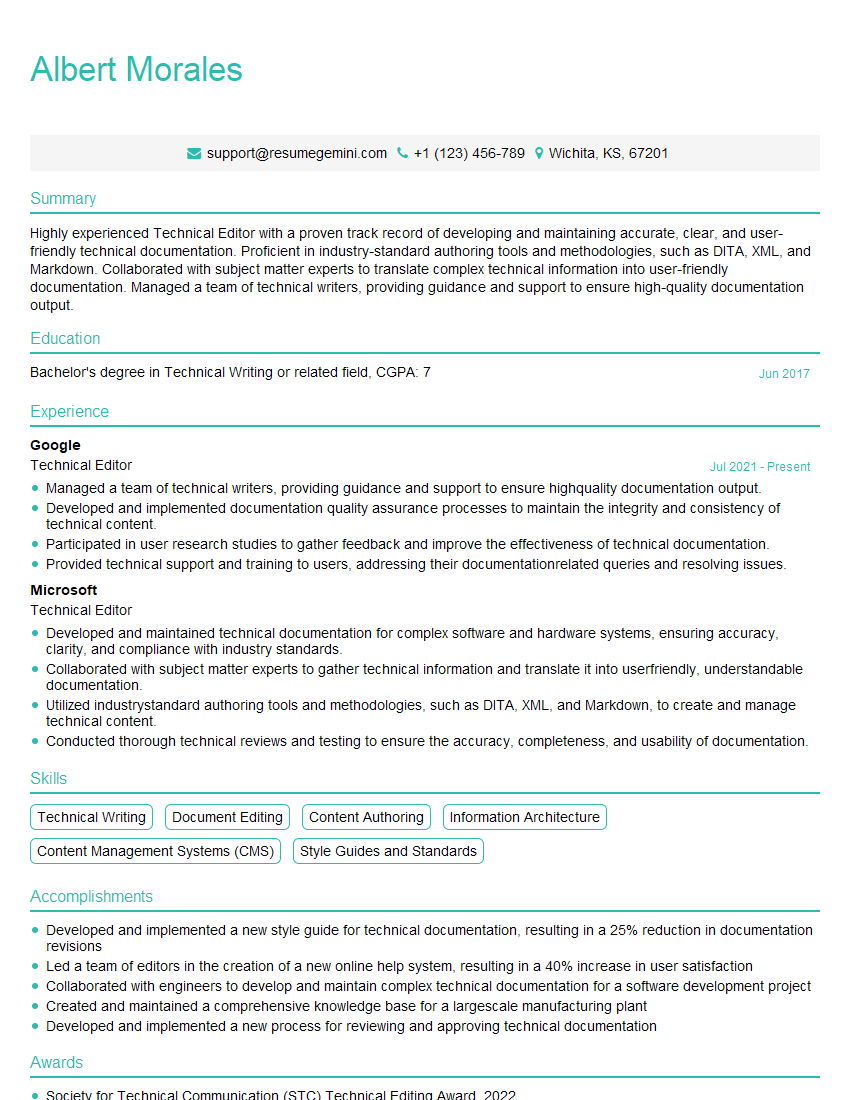Every successful interview starts with knowing what to expect. In this blog, we’ll take you through the top Copyediting and Substantive Editing interview questions, breaking them down with expert tips to help you deliver impactful answers. Step into your next interview fully prepared and ready to succeed.
Questions Asked in Copyediting and Substantive Editing Interview
Q 1. What is the difference between copyediting and substantive editing?
Copyediting and substantive editing are both crucial stages in the editing process, but they focus on different aspects. Think of it like this: copyediting is the surface cleanup, while substantive editing is the deep dive.
- Copyediting: This focuses on surface-level errors. It’s about ensuring consistency in style, grammar, punctuation, spelling, and formatting. It’s like polishing a finished piece of furniture – making sure everything is smooth and visually appealing. Copyeditors often work with a style guide to maintain consistency.
- Substantive editing: This involves a more in-depth review of the content itself. It’s about improving the clarity, accuracy, flow, logic, and overall effectiveness of the writing. It’s akin to redesigning the furniture itself – altering its structure and functionality to better suit its purpose. Substantive editors might suggest reorganizing paragraphs, rewriting sentences, adding or deleting information, and even questioning the author’s arguments.
For example, a copyeditor might correct a misplaced comma, while a substantive editor might suggest rewriting an entire paragraph to clarify a confusing point.
Q 2. Explain your process for copyediting a complex technical document.
My process for copyediting a complex technical document is systematic and multi-stage. It begins with a thorough understanding of the document’s purpose and intended audience.
- Pre-read: I first read through the document to get a general overview of the content, identifying any major structural issues or inconsistencies before diving into the line-by-line editing.
- Style Guide Review: I carefully review the relevant style guide (e.g., Chicago Manual of Style for academic papers, AP Style for journalism) to ensure consistency throughout the document.
- Line-by-line editing: I systematically edit the document, checking for grammar, spelling, punctuation, consistency in terminology and style, and adherence to the style guide. I use track changes to clearly highlight all my edits.
- Fact-checking: For technical documents, I meticulously fact-check all data, figures, and claims, verifying information from reliable sources.
- Consistency Check: I conduct a final review to ensure consistent use of terminology, capitalization, abbreviations, and formatting throughout the document.
- Proofread: A final read-through focuses on catching any remaining errors overlooked in earlier stages.
Throughout this process, I maintain detailed notes and communicate any significant changes or questions to the author for clarity and approval.
Q 3. How do you handle conflicting style guides?
Handling conflicting style guides requires careful judgment and clear communication. My approach prioritizes consistency and clarity within the document, while aiming to meet the overall needs of the project.
- Identify the primary style guide: I first determine which style guide takes precedence based on the client’s instructions or the document’s intended publication.
- Prioritize consistency: Once a primary style guide is identified, I strive for consistency within that guide. Minor deviations might be acceptable if they enhance clarity or readability but should be documented.
- Create a style sheet: For complex projects with multiple style guide elements, I create a custom style sheet to document specific decisions made in handling inconsistencies. This ensures uniformity throughout the document.
- Communicate with the client/author: I proactively communicate any conflicts and my chosen resolution strategy with the client or author to ensure agreement and transparency.
For instance, if a project uses elements of both AP Style and Chicago, I would prioritize the designated style guide and note any exceptions clearly. Transparency and communication are key to managing such scenarios successfully.
Q 4. Describe your experience with fact-checking and verification.
Fact-checking and verification are integral parts of my editing process, especially when dealing with technical documents, research papers, or journalistic pieces. My approach is methodical and thorough.
- Source identification: I meticulously identify and verify the source of all factual information. This includes checking the credibility and reliability of the source.
- Cross-referencing: I often cross-reference information with multiple sources to ensure accuracy and consistency. I look for corroborating evidence to support claims.
- Data validation: For numerical data, I double-check calculations and figures to ensure accuracy. I use appropriate tools to verify statistical analyses.
- Citation verification: I ensure that all citations are accurate and complete, following the specified citation style.
In a recent project involving a scientific report, I discovered an inconsistency in a data point. By carefully cross-referencing with the raw data and contacting the researcher, I identified and corrected the error, ensuring the report’s accuracy.
Q 5. How do you identify and correct grammatical errors and inconsistencies?
Identifying and correcting grammatical errors and inconsistencies requires a keen eye for detail and a strong understanding of grammar rules. My approach is both proactive and reactive.
- Proactive approach: I use grammar checkers and style guides as tools to flag potential errors but rely on my own expertise to confirm and make the correct changes. I understand that automated tools are not always accurate.
- Reactive approach: As I read, I carefully look for grammatical errors like subject-verb agreement, pronoun-antecedent agreement, tense consistency, misplaced modifiers, and faulty parallelism. I also note any inconsistent use of punctuation or style.
- Contextual understanding: Correcting grammatical errors also requires contextual understanding. I consider the meaning and intent of the text to make sure the correction improves the writing without changing its meaning.
For example, I might change “The cat sat on the mat, sleeping soundly” to “The sleeping cat sat on the mat” to correct the misplaced modifier and improve the flow.
Q 6. What strategies do you use to ensure accuracy and consistency in editing?
Ensuring accuracy and consistency in editing is paramount. My strategies focus on meticulousness and systematic review.
- Style guide adherence: Consistent application of a style guide is essential. I always start by familiarizing myself thoroughly with the relevant style guide before beginning the editing process. I create a custom style sheet if necessary.
- Multiple passes: I often make multiple passes through the document, focusing on different aspects in each pass (e.g., grammar in one pass, fact-checking in another).
- Track changes: Utilizing track changes software enables clear documentation of all edits, facilitating easy review and collaboration with authors.
- Detailed notes: I provide detailed notes explaining the rationale behind all edits. This is particularly important for substantive edits.
- Proofreading: A final proofread after completing all edits ensures that no errors are missed. I often read the document aloud or backward to aid in this process.
This multi-layered approach helps catch errors and maintain consistency throughout the entire document, ensuring a high-quality final product.
Q 7. How familiar are you with AP Style, Chicago Manual of Style, or other style guides?
I am very familiar with AP Style, Chicago Manual of Style, and other style guides. My experience includes extensive use of these guides across various writing projects. My familiarity goes beyond just knowing the rules; I understand the rationale behind them and can apply them flexibly and appropriately to suit the needs of specific projects.
I’ve worked with various style guides including MLA, APA, and even specialized style guides used in particular industries (e.g., medical journals, legal documents). My ability to adapt to different style guides is a valuable asset, allowing me to maintain consistency and professionalism in all projects I undertake.
Q 8. How do you prioritize edits when facing tight deadlines?
Prioritizing edits under tight deadlines requires a strategic approach. I begin by identifying the most crucial elements – for instance, in a marketing piece, ensuring the call to action is clear and compelling takes precedence over minor grammatical tweaks. I use a triage system: critical errors (factual inaccuracies, misleading information) are addressed first, followed by major errors (grammatical blunders affecting clarity) and finally minor errors (typos, stylistic inconsistencies).
I often employ a timeboxing technique, allotting specific time blocks to different tasks. For example, I might dedicate 30 minutes to fixing factual errors, an hour to correcting major grammatical issues, and the remaining time for polishing the piece. This approach prevents me from getting bogged down in less important details when time is short. It’s like a surgeon focusing on life-saving procedures before attending to minor wounds.
Q 9. Explain your approach to working with authors or clients who are resistant to edits.
Working with resistant authors or clients requires diplomacy and strong communication skills. I avoid directly confronting their resistance. Instead, I focus on building consensus. I start by explaining my edits clearly and concisely, emphasizing how they improve clarity, consistency, or impact. I provide concrete examples, showing how the revised text enhances the overall message. I never dismiss their perspective; instead, I present my edits as suggestions rather than demands, offering explanations for my choices.
If resistance persists, I suggest a collaborative approach. We could discuss specific edits they’re hesitant about, allowing me to address their concerns and demonstrate the rationale behind my suggestions. In some cases, I might even offer alternative solutions to address their concerns while still achieving the desired improvements. It’s a delicate balance of persuasion and collaboration; remember, their project is their baby and we need to respect that.
Q 10. Describe your experience with using editing software (e.g., MS Word Track Changes, Adobe Acrobat).
I am highly proficient in using various editing software, including MS Word’s Track Changes and Adobe Acrobat. Track Changes is invaluable for collaborative editing, allowing authors to review my edits and provide feedback in a clear, organized manner. I find the ability to comment and suggest revisions directly within the text incredibly useful, leading to a smoother workflow and clearer communication.
Adobe Acrobat is especially helpful when working with PDFs, particularly for larger documents or those with complex layouts. I use its commenting and markup tools to highlight areas needing attention and to communicate my edits efficiently. My experience encompasses using both programs for different types of editing projects, from simple blog posts to lengthy academic papers. The choice of software is always project-dependent, but my skills across both are key.
Q 11. How do you handle ambiguous or unclear writing?
Ambiguous or unclear writing requires careful analysis and clarification. My first step involves identifying the source of the ambiguity. Is it due to vague word choice, unclear sentence structure, or a lack of contextual information? Once the source is identified, I either suggest more precise language or request clarification from the author. For example, if the text states ‘the project was delayed’, I might inquire about the reasons for the delay to add specificity and improve clarity.
If the author is unavailable, I carefully consider the context to infer the intended meaning. However, I always note my assumptions and highlight these areas in my edit so the author is aware of my interpretations and can verify or correct them. I believe in transparency during the editing process. It’s always better to err on the side of caution and ask than to make assumptions that could lead to misinterpretations.
Q 12. How do you identify and correct structural problems in a text?
Identifying and correcting structural problems involves a holistic approach. I begin by reading the text thoroughly to understand its overall flow and argument. I then look for inconsistencies, such as illogical transitions, repetitive information, or missing supporting evidence. I assess the organization of the text, considering whether the introduction, body paragraphs, and conclusion are well-structured and effectively linked.
Common structural issues I address include improving paragraph coherence, reorganizing sections for better flow, adding transitions to bridge ideas smoothly, and ensuring that all supporting details are relevant and placed appropriately. For example, if a crucial piece of evidence is buried deep within the text, I might recommend moving it to a more prominent position for better impact. The structure of the text should seamlessly guide the reader from start to finish.
Q 13. Explain your understanding of different types of editing (developmental, line, copy, proofreading).
Different types of editing serve distinct purposes. Developmental editing focuses on the big picture – the manuscript’s overall structure, plot, character development (in fiction), and argument (in non-fiction). It’s about improving the content and making sure the writing is effective and achieves its goals. Substantive editing (often used interchangeably with developmental editing, though more focused on the text) addresses issues of content, organization, and clarity at a paragraph and sentence level. It might involve rewriting sections to improve flow and cohesion.
Copy editing focuses on grammar, style, consistency, and factual accuracy. It involves correcting errors at the sentence and paragraph levels while ensuring adherence to style guidelines. Proofreading is the final stage, concentrating on typographical errors, spelling mistakes, and other minor inconsistencies before publication. It’s a meticulous check for minor errors, unlike the more conceptual approach of substantive and developmental editing.
Q 14. How do you manage multiple projects simultaneously?
Managing multiple projects simultaneously demands strong organizational skills and effective time management. I use project management tools like Asana or Trello to track deadlines, assign priorities, and monitor progress. Each project has a dedicated workspace, making it easy to keep track of individual tasks and their status. I break down larger projects into smaller, manageable tasks, ensuring each task is assigned a realistic timeframe.
Prioritization is key. I often use methods like the Eisenhower Matrix (urgent/important) to identify the most critical tasks and allocate my time accordingly. Regularly reviewing my schedule and adjusting priorities as needed is also crucial. Think of it as conducting an orchestra – each instrument (project) needs attention, but some require more focus than others at different times. Effective scheduling and prioritization allows me to deliver quality work on all projects without feeling overwhelmed.
Q 15. How do you provide constructive feedback to authors?
Providing constructive feedback to authors requires a delicate balance of honesty and encouragement. My approach focuses on clarity, specificity, and respect for the author’s work. I begin by identifying the strengths of the piece, highlighting what works well before addressing areas for improvement. This positive reinforcement sets a collaborative tone.
For instance, instead of saying “This section is confusing,” I might say, “This section about the character’s motivations could benefit from clearer exposition. Perhaps a brief flashback showing their past experiences would help the reader understand their actions.”
I use a clear and concise style, avoiding vague terms like “improve” or “fix.” Instead, I offer concrete suggestions and examples. I also prioritize actionable feedback – suggestions that the author can readily implement. Finally, I always offer my feedback in a respectful and supportive manner, emphasizing that the goal is to elevate the writing to its full potential.
Career Expert Tips:
- Ace those interviews! Prepare effectively by reviewing the Top 50 Most Common Interview Questions on ResumeGemini.
- Navigate your job search with confidence! Explore a wide range of Career Tips on ResumeGemini. Learn about common challenges and recommendations to overcome them.
- Craft the perfect resume! Master the Art of Resume Writing with ResumeGemini’s guide. Showcase your unique qualifications and achievements effectively.
- Don’t miss out on holiday savings! Build your dream resume with ResumeGemini’s ATS optimized templates.
Q 16. What is your approach to editing different genres (e.g., fiction, non-fiction, technical)?
Editing different genres requires adapting my approach to the unique conventions and expectations of each. Fiction editing necessitates a keen understanding of narrative structure, character development, and pacing. My focus is on enhancing the reader’s experience through improvements in plot, characterization, and prose. I might need to pay close attention to the development of themes and the subtleties of language.
Non-fiction editing demands accuracy, clarity, and adherence to factual information. Here, rigorous fact-checking, ensuring consistency in style, and streamlining complex information for readability are crucial. I pay close attention to source verification and appropriate use of citations.
Technical writing requires a different approach entirely, focusing on clarity, precision, and accessibility for a target audience. My edits will ensure the document is free of ambiguities, adheres to technical standards, and uses appropriate terminology. I may need to work closely with technical experts to ensure the accuracy of the information.
In all genres, my overarching approach is to improve the clarity, conciseness, and overall effectiveness of the writing, always keeping the intended audience in mind.
Q 17. How do you ensure the clarity and conciseness of written material?
Clarity and conciseness are paramount in effective writing. I achieve this through a multi-step process. First, I carefully read the text to identify any ambiguous sentences, redundant phrases, or unnecessary jargon. I then rework sentences to eliminate wordiness, using strong verbs and precise nouns. I look for opportunities to simplify complex sentences and combine shorter ones for a better flow.
For instance, a sentence like “Due to the fact that the project experienced unforeseen complications, it was delayed” can be simplified to “Unforeseen complications delayed the project.” I also actively remove clichés, qualifiers like “very” or “really,” and unnecessary adverbs.
I use tools like readability analysis software to assess the overall clarity of the text and make sure the writing is appropriate for the intended audience. Finally, I always test the revised text by reading it aloud, which helps identify awkward phrasing and improve the overall rhythm and flow.
Q 18. How do you maintain consistency in style, tone, and voice throughout a document?
Maintaining consistency in style, tone, and voice is essential for a professional and polished document. I begin by identifying the desired style guide (e.g., Chicago Manual of Style, AP Stylebook) and meticulously applying its rules throughout the text. I use style checkers and pay attention to details such as capitalization, punctuation, and formatting.
Consistency in tone is equally vital. I carefully assess the overall tone of the document and ensure it remains consistent throughout. This often involves identifying and correcting any shifts in tone that might confuse or disorient the reader. For example, I’d avoid switching between formal and informal language without good reason.
Similarly, I ensure the voice remains consistent. The voice reflects the persona or identity of the writer. Whether it is formal, informal, authoritative, or playful, it must remain constant throughout the document to avoid jarring the reader.
I often create a style sheet as a reference throughout the editing process, noting specific choices regarding punctuation, capitalization, and terminology, ensuring everything remains consistent.
Q 19. Describe your experience with indexing.
I have extensive experience in indexing, having created both print and online indexes for various publications and books. My process starts with a thorough understanding of the content’s organization and key concepts. Then I identify keywords and subheadings using a combination of manual reading and the use of indexing software.
I pay close attention to cross-referencing to ensure that related terms are linked, enhancing the index’s usability. I meticulously organize the terms alphabetically and, where appropriate, create a hierarchical structure to improve navigation. After generating the initial index, I conduct rigorous quality checks, ensuring accuracy and completeness. This often involves reviewing the finished index against the source material.
My experience includes working with different indexing software programs and adapting my approach based on the specific needs of the project. Whether a detailed subject index or a concise keyword index, I strive for clear, concise, and user-friendly results.
Q 20. How do you handle sensitive or controversial content?
Handling sensitive or controversial content requires a nuanced approach that balances editorial responsibility with ethical considerations. My priority is to ensure accuracy and avoid perpetuating harmful stereotypes or misinformation. If the content requires fact-checking or verification of potentially biased claims, I will thoroughly investigate those aspects.
I will be mindful of potential sensitivities surrounding the topic. For instance, I will pay particular attention to language and terminology used when addressing issues of race, gender, religion, or sexual orientation. My goal is to present information objectively and fairly, while ensuring the language used respects the reader and avoids causing offense.
Sometimes, sensitive content may require discussion with the author or publisher to clarify their intent and determine the appropriate way to present the information to readers. Ultimately, I aim to create a document that is informative, respectful, and avoids perpetuating harm.
Q 21. What is your experience with working remotely and using collaboration tools?
I have extensive experience working remotely and collaborating effectively using various tools. My remote workflow includes using cloud-based platforms for file sharing and collaboration, like Google Drive or Dropbox. For communication, I rely on email, video conferencing (Zoom, Skype), and project management software (Asana, Trello).
I’m comfortable with version control systems, ensuring that all changes are tracked and easily accessible for review. I understand the importance of clear and concise communication when working remotely and prioritize regular check-ins with authors and clients to keep projects on track. I’ve successfully completed numerous projects remotely, demonstrating my ability to manage my time effectively, communicate clearly, and meet deadlines independently.
I’m adept at using feedback tools and providing constructive critiques online. For example, I can effectively use track changes in documents to offer suggestions and revisions and then engage in productive discussion threads to discuss and implement changes collaboratively.
Q 22. How do you stay updated with changes in style guides and industry best practices?
Staying current in the ever-evolving world of style guides and best practices is crucial for any editor. I employ a multi-pronged approach. Firstly, I subscribe to relevant professional journals and newsletters, such as those published by the Chicago Manual of Style organization or the American Copy Editors Society. These publications often feature updates on style guide changes and emerging trends. Secondly, I actively participate in online forums and professional development webinars. These offer opportunities to learn from other editors and engage in discussions about current challenges and best practices. For example, recent discussions around inclusive language and data visualization standards have greatly shaped my editing approach. Thirdly, I regularly review updated versions of major style guides – the Chicago Manual of Style, AP Stylebook, and others, depending on the project’s requirements. This ensures I’m familiar with the latest rules and recommendations. Finally, I regularly audit my own work, reflecting on areas for improvement based on recent industry trends and feedback received.
Q 23. How do you deal with a difficult or demanding client?
Handling demanding clients requires a combination of professionalism, clear communication, and a problem-solving mindset. My first step is to actively listen to their concerns and understand their perspective. Often, perceived demands stem from a lack of clarity or differing expectations. I address this by providing a thorough project timeline, outlining the editing process, and establishing clear communication channels. For instance, if a client wants a rush job, I’ll explain the potential impact on quality and offer alternative solutions, like prioritizing certain sections or adjusting the scope. If disagreements arise, I maintain a calm and respectful demeanor, offering evidence-based explanations for my editorial decisions. Ultimately, building trust through transparency and professionalism helps resolve most conflicts. If a client remains unreasonable, I document all interactions and consult with my supervisor to ensure the project’s success and my own professional well-being. Think of it like navigating a difficult conversation; empathy and proactive communication are key.
Q 24. What are your strengths and weaknesses as an editor?
My greatest strengths as an editor are my meticulous attention to detail, my strong grasp of grammar and style, and my ability to adapt quickly to different writing styles and project requirements. I’m confident in my ability to identify inconsistencies, maintain clarity and flow, and ensure accuracy in all types of writing, from academic papers to marketing materials. For example, I recently helped a client clarify a complex technical document by reorganizing sections, creating clearer headings, and simplifying jargon. However, I also recognize my weaknesses. Sometimes, when deeply immersed in a project, I can be too focused on the details and overlook the bigger picture. To combat this, I’ve developed a workflow that incorporates regular breaks and self-reviews to ensure I maintain a balanced perspective and catch any potential oversights.
Q 25. Describe a time you had to make a difficult editing decision.
One time, I was editing a historical biography where the author made several assertions about a controversial figure without citing sufficient evidence. This presented a difficult decision: to leave the assertions as they were and risk compromising the book’s credibility or to significantly alter the text, potentially upsetting the author. After careful consideration, I chose a middle ground. I flagged the questionable assertions with detailed comments for the author, recommending the addition of sources and clarifying the claims to avoid misrepresentation. I also presented alternative phrasing options that maintained the author’s intent without sacrificing historical accuracy. The solution involved a collaborative discussion with the author, leading to a strengthened and more reputable manuscript. The key was to prioritize factual accuracy without undermining the author’s voice or creative intent. It taught me the importance of clear communication and collaborative problem-solving when faced with ethically complex editorial challenges.
Q 26. How do you handle feedback from others on your editing work?
I consider feedback an invaluable opportunity for growth and improvement. I approach all feedback, whether positive or negative, with an open mind. I carefully review each suggestion, considering its validity within the context of the project and my understanding of style guidelines. If I disagree with a suggestion, I’ll explain my reasoning clearly and respectfully, backing it up with evidence and examples from relevant style guides. If I agree, I’ll implement the changes, ensuring accuracy and consistency. I believe the process of providing and receiving constructive feedback is a vital part of producing high-quality work. It’s about continuous learning and refinement, ultimately leading to stronger editing skills.
Q 27. What are your salary expectations for this role?
My salary expectations are commensurate with my experience, skills, and the requirements of this role. Having researched industry standards and considering my expertise in both copyediting and substantive editing, I am seeking a salary in the range of [Insert Salary Range]. I’m confident this aligns with the value I bring to your organization, and I’m open to discussing this further.
Key Topics to Learn for Your Copyediting and Substantive Editing Interview
- Grammar and Mechanics: Mastering punctuation, grammar rules, and style guides (e.g., AP, Chicago) is fundamental. Practice identifying and correcting errors swiftly and accurately.
- Style and Tone: Understand how to adapt writing style to suit different audiences and publication types. Practice maintaining consistency in tone and voice throughout a document.
- Fact-Checking and Verification: Learn effective strategies for verifying information, identifying inconsistencies, and ensuring accuracy. This is crucial for substantive editing.
- Structural Editing (Substantive): Develop your skills in organizing information logically, improving flow and readability, and suggesting structural changes to enhance clarity and impact. Practice identifying weaknesses in argumentation and suggesting solutions.
- Copyediting (Line Editing): Focus on refining sentence structure, word choice, and overall clarity at the sentence level. Practice identifying and correcting typos, inconsistencies, and grammatical errors.
- Proofreading: Develop keen attention to detail to catch any remaining errors after substantive and copyediting. Practice proofreading techniques to ensure a polished final product.
- Understanding Different Content Types: Familiarize yourself with editing various content formats, such as academic papers, marketing materials, websites, and books. Each requires a unique approach.
- Collaboration and Communication: Practice articulating your editing decisions clearly and professionally, both in writing and verbally. Understand how to provide constructive feedback.
- Software Proficiency: Demonstrate familiarity with common editing software and tools (e.g., MS Word, Google Docs). Highlight your proficiency in using track changes and other relevant features.
Next Steps
Mastering copyediting and substantive editing skills opens doors to diverse and rewarding careers in publishing, journalism, marketing, and beyond. To maximize your job prospects, invest time in crafting a compelling and ATS-friendly resume that highlights your skills and experience effectively. ResumeGemini is a trusted resource to help you build a professional resume that showcases your abilities and gets you noticed. They offer examples of resumes tailored specifically to Copyediting and Substantive Editing roles, providing a great starting point for your job search.
Explore more articles
Users Rating of Our Blogs
Share Your Experience
We value your feedback! Please rate our content and share your thoughts (optional).
What Readers Say About Our Blog
Interesting Article, I liked the depth of knowledge you’ve shared.
Helpful, thanks for sharing.
Hi, I represent a social media marketing agency and liked your blog
Hi, I represent an SEO company that specialises in getting you AI citations and higher rankings on Google. I’d like to offer you a 100% free SEO audit for your website. Would you be interested?

